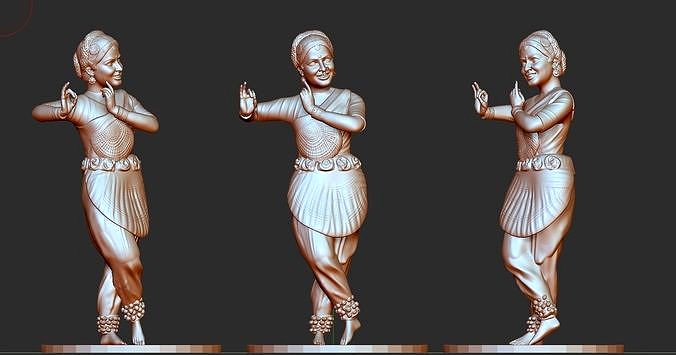CG Trader

Kathak girl | 3D
by CG Trader
Last crawled date: 1 year, 6 months ago
Kathak is one of the eight major forms of Indian classical dance.It is the classical dance form of Uttar Pradesh. The origin of Kathak is traditionally attributed to the traveling bards in the of ancient northern India known as Kathakars or storytellers.[1] The term Kathak is derived from the Vedic Sanskrit word Katha which means story, and Kathakar which means the one who tells a story, or to do with stories.[1][2] Wandering Kathakars communicated stories from the great epics and ancient mythology through dance, songs and music.[2] Kathak dancers tell various stories through their hand movements and extensive footwork, their body movements and flexibility but most importantly through their facial expressions. Kathak evolved during the Bhakti movement, particularly by incorporating the childhood and stories of the Hindu god Krishna, as well as independently in the courts of north Indian kingdoms.[1][3] During the period of Mughal rule, the emperors were patrons Kathak dance and actively promoted it in their royal court. [4] Kathak performances include Urdu Ghazals and commonly used instruments brought during the Mughal period.[5] As a result, it is the only Indian classical dance form to feature Persian elements.[6] Kathak is found in three distinct forms, called gharanas, named after the cities where the Kathak dance tradition evolved – Jaipur, Banaras and Lucknow.[7] While the Jaipur gharana focuses more on the foot movements, the Banaras and Lucknow gharanas focus more on facial expressions and graceful hand movements. Stylistically, the Kathak dance form emphasizes rhythmic foot movements, adorned with small bells (Ghungroo) and the movement harmonized to the music.[3][8] The legs and torso are generally straight, and the story is told through a developed vocabulary based on the gestures of arms and upper body movement, facial expressions, neck movements, eyes and eyebrow movement , stage movements, bends and turns. The main focus of the dance becomes the eyes and the foot movements. The eyes work as a medium of communication of the story the dancer is trying to communicate. With the eyebrows the dancer gives various facial expressions.[3][9] The difference between the sub-traditions is the relative emphasis between acting versus footwork, with Lucknow style emphasizing acting and Jaipur style famed for its spectacular footwork.[3] Kathak as a performance art has survived and thrived as an oral tradition, innovated and taught and from one generation to another verbally and through practice.[10] It transitioned, adapted and integrated the tastes of the Mughal courts[11] in the 16th and 17th centuries, particularly by Akbar, but stagnated and went into decline during the British colonial era,[12] then was reborn as India gained independence and sought to rediscover its ancient roots and a sense of national identity through the arts.[9][10 kattak dance yoga nritya dancer girl pose youg art sculptures
Similar models
cg_trader
$15

Balinese Legong Dancer Wood Sculpture - RT Scanned
...ese dance form characterized by intricate finger movements, complicated footwork, and expressive gestures and facial expressions.
cg_trader
$30

Balinese Legong Dancer Wood Sculpture - ED Scanned
...ese dance form characterized by intricate finger movements, complicated footwork, and expressive gestures and facial expressions.
cg_trader
$25

Bharatanatyam Dancer Female Rigged
...onal indian dance female woman lady costume dress 3dsmax mentalray female character female character indian woman woman character
cg_trader
$35

red Indian High quality character full Rigged and Animated
...red indian high quality character full rigged and animated
cg trader
you can animate facial expressions movements on 1800 frames
cg_trader
$250

Kathakali south indian danceform Toy | 3D
...dian danceform toy | 3d
cg trader
kathakali traditional south indian dance form, this can be used as an art piece chumbak toys
free3d
$149

Cindy-swimsuit-rigged
...
blender (blend) file also includes facial expressions:
(smile, blink for both eyes, sad, angry, eyebrows up for both eyebrows)
free3d
$145

Tom-casual-rigged
...
blender (blend) file also includes facial expressions:
(smile, blink for both eyes, sad, angry, eyebrows up for both eyebrows)
cults
$1

dancer body
... postural statue movement
postural study dancers
movements worked on posing.
height 160mm
blender software, posing, cura
cg_trader
$25

Facial Expression 0-00 Eyes Closed
...facial expression 0-00 eyes closed
cg trader
high poly 3d scanned facial expression: *
cg_trader
$15

Fat star dancer
...ht. man danse dance dancer ballerina ballet fat obese big light classic classical music character ballet dancer fat man music man
Girl
3d_export
$10

Girl
...girl
3dexport
girl
3d_export
$7

girl
...girl
3dexport
girl
3d_export
$6

girl
...girl
3dexport
girl
3d_export
$19

girl
...girl
3dexport
girl 3d model
3d_export
$5

girl
...girl
3dexport
hip hop dancing girl
archibase_planet
free

Girl
...girl
archibase planet
girl woman people
girl n090814 - 3d model (*.gsm+*.3ds) for 3d visualization.
archibase_planet
free

Girl
...girl
archibase planet
girl woman people
girl n210115 - 3d model (*.gsm+*.3ds) for 3d visualization.
archibase_planet
free

Girl
...girl
archibase planet
girl child people
girl 1 n230614 - 3d model (*.gsm+*.3ds) for 3d visualization.
archibase_planet
free

Girl
...girl
archibase planet
girl woman people
girl 3 n230614 - 3d model (*.gsm+*.3ds) for 3d visualization.
archibase_planet
free

Girl
...girl
archibase planet
girl woman people
girl walking n090814 - 3d model (*.gsm+*.3ds) for 3d visualization.
